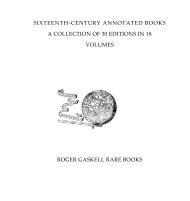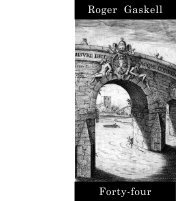pdf - Roger Gaskell Rare Books
pdf - Roger Gaskell Rare Books
pdf - Roger Gaskell Rare Books
You also want an ePaper? Increase the reach of your titles
YUMPU automatically turns print PDFs into web optimized ePapers that Google loves.
161<br />
RIDLEY, Mark (1560–1624)<br />
A short treatise of magneticall bodies and motions.<br />
London: printed by Nicholas Okes, 1613.<br />
4to: A4 (A2+a4 ) B–V4 X4 (+/–X3) (blanks A1 and X4), 88 leaves, pp.<br />
[16] 157 [3] (Wrst and last 2 pages blank). Woodcut initials, printer’s<br />
woodcut device dated 1610 on colophon on X3. Engraved titlepage<br />
on A2 signed ‘R: Elstrak sculpsit’ (Johnson p. 15), engraved portrait<br />
on a4v, 20 threequarter page engravings in the text numbered Tab.<br />
I–XX, that on T4 with a movable quadrant attached by a thread, 1<br />
unnumbered halfpage engraving on p. 143 and one woodcut on p. 152.<br />
191 x 145mm. Purple mildew stains throughout but the paper<br />
apparently resized and crisp; minor repairs to Wrst few leaves and initial<br />
and terminal blanks and some other leaves chipped in the margins.<br />
Binding: Newly stabsewn and recased in what could be the original<br />
vellum wrapper made from a contemporary indenture.<br />
First edition, second issue with X3 cancelled and errata printed on the<br />
replacement leaf. STC 21045.5; ESTC S123258; Adams & Waters,<br />
2976; Wheeler Gift 86.<br />
A landmark in the history of experimental science in England, this was the<br />
most important work on magnetism after Gilbert’s De magnete (1600).<br />
‘Dr Ridley, following up Dr Gilbert’s work, here presented directions for<br />
a series of experiments on the lodestone, magnet, and terella which could<br />
be carried out by anyone interested in the subject. He added engravings and<br />
descriptions of his improvised instruments for determining the variation, and<br />
for making use of the inclinatory needle for Wnding position at sea. This was<br />
in accordance with the method published jointly by Edward Wright, Thomas<br />
Blundeville, and Henry Briggs.’ (Taylor, Works, 126).<br />
Like Gilbert, Ridley was a prominent fellow of the College of Physicians and<br />
the two were close friends. But Ridley was dismissive of another contemporary<br />
experimenter who was in contact with Gilbert, William Barlow. Barlow accused<br />
Ridley of plagiarism, saying that Gilbert had shown Ridley the manuscript<br />
of his Magneticall advertisements, not published until 1616. Ridley replied to<br />
this accusation in his only other published work, Magnetical animadversions<br />
(1617). He there ridiculed Barlow’s antiCopernican arguments, pointing<br />
out the recent discovery of Jupiter’s satellites by the telescope. It is therefore<br />
interesting that Jupiter’s satellites are shown on the engraved titlepage of the<br />
present work, published 4 years earlier.<br />
In his address to the reader, Ridley discusses the images of the planets on<br />
the titlepage, so presumably he had himself directed the engraver, Renald<br />
Elstrack (1570–1625 or later). The lower half of the engraving seems to<br />
show the entrance to a classical building, Xanked by paired Doric colums,<br />
but above, the building disolves into a display of scientiWc instruments, the<br />
planets, and an elephant with a howdah. Elstrack is regarded as the foremost<br />
English engraver of his time, particularly as a portrait engraver (ODNB).<br />
Johnson identiWed 24 titlepages engraved by him between 1610 and 1624.







